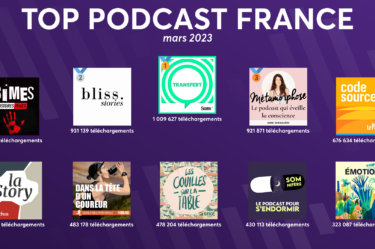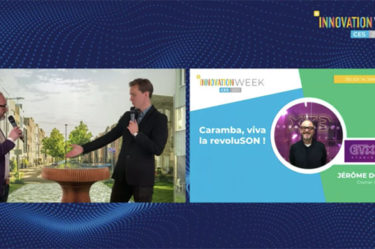Technology continues to change the way we interact with and experience the world, and the pace of innovation is so rapid that it can be hard to keep up. At Relaxnews, we’re interested in connecting tech trends to our work on content creation and we apply our insights to help you achieve your marketing objectives.
Specifically, on the question of content creation, we have begun asking questions like, “What is required to create more relevant and timely content to engage your customers?” Or, “Beyond automation, what role do machines play in targeted marketing?”
The best place to explore is among the best and brightest thought leaders and innovators.
What answers can tech innovators provide?
Last week, Relaxnews attended MIT Technology Review’s event “Innovators Under 35 Europe” at Station F, where a series of young innovators presented groundbreaking projects that use technology to develop solutions to some of the biggest issues facing society. Over a thousand young innovators applied, but only 35 were selected to present. Projects, developed by researchers, entrepreneurs, and innovators, use technology (including artificial intelligence) to respond to challenges in a multitude of sectors, ranging from healthcare to humanitarian projects.
Though each project responded to a unique problem, we identified a few themes that provided an answer to our questions on timely content and the role of machines, which serve as great business insights for you to integrate into your marketing and business strategy. In this article, we highlight relevant examples of improved service and product offerings as presented by Loubna Bourafa of OKRA, Vincent Spruyt of Sentiance, and Vivian Chan of Sparrho.
Who are these innovators?
OKRA is a medical platform that uses segmentation and aggregation to propose optimized, personalized medical care by collecting information on diseases and treatment efficacy so that medical practitioners can easily identify treatments for patients by consulting treatments that have worked for others like them. Sentiance created a technology that can be integrated into mobile applications. The technology is powered by machine learning that uses data from location, acceleration and gyroscope sensors found in smartphones to understand the behaviors, daily events, and specific moments of app users so that companies can help create more personalized packages and mobile experiences for their app users. Sparrho uses algorithms and machine learning to make scientific studies more widely available to students and curious individuals alike. Using a combination of technology and human brain power, Sparrho summarizes scientific findings in 200-300 words, creates pinboards with related topics, and makes science understandable and relatable to a larger audience.
What do these three innovations have in common?
A few things, actually. Each of them demonstrates the increasing importance of personalization, demonstrating its transformative importance for every industry, the need for unique experiences, and the importance of discovery.
In a world full of choices, a blanket solution is no longer an option. As technology continues to advance, users want adapted experiences that make them feel understood and unique. OKRA, Sentiance and Sparrho all leverage machine learning (artificial intelligence) to enhance human capabilities and allow for greater personalization to benefit the end user. The key to successful enhancement of personalization lies in pattern detection and segmentation.
In OKRA’s case, machines take a personal experience (receiving health care one-on-one from a medical professional) and further personalize it using data sets stored on a platform so that a patient is treated based on his or her own individual needs and characteristics, and not based on the results of an isolated test group. Here, machine learning provides a very flexible way of validating new drugs and treatments that not only help medical professionals do their jobs more efficiently but also makes patients’ individual needs a priority. A patient thus receives the customized treatment he or she needs, while medical insurers and pharmaceutical companies are also consequently able to improve their products and services without adverse consequences.
Somewhat similarly, Sentiance uses machine learning and big data aggregation of this type to serve companies like Samsung (who uses this information for its health app) and Risk (a Danish insurance company who uses user data to offer personalized driver insurance packages). The data collected from users allows for segmentation of customers based on their behaviors and for analysis of each user’s particular context. As such, not only are those analyzing the patterns able to understand what their users do each day, but also why they do it, allowing companies to propose adapted content and service or product offerings to their customers, based on the needs and desires created by their everyday activities.
Finally, Sparrho uses its machines to make human tasks easier. Given that scientific research and studies are not always well-communicated or easily accessible; her platform serves first and foremost to help people get access to those things. Studies are identified by machines using keywords and association, grouped, and then summarized and translated by a network of over 65,000 Ph.D.’s internationally. However, the simplification and summarization of that information make Sparrho attractive to curious learners who are not necessarily a part of the scientific community, but are interested in topics like, “What should I know about living on Mars?” Pinboards, like those you might find on Pinterest, are then created by users of the platform and machine learning makes that platform useful to outsiders by recommending “related” topics or topics that may be of interest to users. Beyond their practical use and the personalized nuance that these pinboards provide, they also reveal the need for discovery in personalization. Users want a unique experience, but that experience must not exclude the possibility for unique exploration.
These innovations mark a fundamental shift in the way that the customer experience is imagined and give “customer-centric” new meaning. Personalization has been on the rise for quite some time, but the increased use of machine learning to improve customer satisfaction is likely to create a new standard for service.
Though there are still questions about privacy, users are now aware that their information can be used to bring them an improved experience. According to Vincent Spruyt, Vice President of Data Science at Sentiance, users are willing to exchange data for value. So long as they understand the benefits (better insurance premiums, more relevant, less intrusive content, a personalized coach, to list a few examples) of sharing their data with a company and maintain a sense of control (over what data is shared and how it is used), they are typically comfortable sharing it.
What are the takeaways here?
It is no longer enough to simply push a singular message, adapted to “your audience” (the catchall phrase for “all of our consumers respond to this”) into traditional spaces (paid advertisements) and hope for an impact. The key to success is to personalize and contextualize while maintaining an element of surprise and discovery. Your users, whether subscribers to your newsletter or blog or users of your application, should feel like you are not only trying to add value to their experiences but also that you recognize that each person is unique.
In a few words: if you haven’t found a way to personalize your messaging and user experience, you need to.
From a content perspective, this means learning about and adapting to your users preferences. Relaxnews tries to help you hone in on the interests of your readers by providing you with tools on the my editorializer platform to help you create content that will better engage customers.
What do those interested in the topics you cover in your marketing materials typically read or click on? Learn what relevant information sources are saying about topics you cover. At Relaxnews, this translates into searching a subject and finding other relevant keywords via the Radar tool on the my editorializer platform. As you consider tagging keywords before you diffuse your content, consider what unique value you add to your customers’ experience. How can you help them discover better? We currently approach discovery by offering related sources on our Radar tool so that your next piece of content will better engage customers.
For help creating more personalized, discovery-worthy content, contact us.






